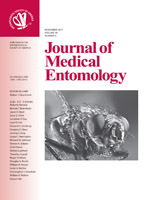Despite the importance of per-capita feeding rates for mosquito-borne transmission dynamics, the relationship between host aggregation and per-capita feeding rates remains poorly characterized. We conducted indoor experiments to investigate how Culex quinquefasciatus (Say) mosquitoes distribute their blood feeding on variably aggregated domestic chickens (Gallus gallus domesticus L.) (one chicken vs. a flock of seven to nine birds). Mosquitoes were always more likely to feed on the larger chicken group; yet, the single chicken tended to be fed on at a higher per-capita rate. When 10 chickens were available the feeding intensity was 4.5 times higher for the single chicken compared with the flock. We conclude that more highly aggregated hosts may experience lower exposure to mosquito bites than less aggregated hosts.
How to translate text using browser tools
1 November 2011
Disproportionate Mosquito Feeding on Aggregated Hosts
Ivo M. Foppa,
Jerrilynn Moore,
Kevin A. Caillouët,
Dawn M. Wesson
ACCESS THE FULL ARTICLE
It is not available for individual sale.
This article is only available to subscribers.
It is not available for individual sale.
It is not available for individual sale.

Journal of Medical Entomology
Vol. 48 • No. 6
November 2011
Vol. 48 • No. 6
November 2011
host aggregation
mosquito-borne disease transmission
per-capita feeding rate
transmission dynamics




